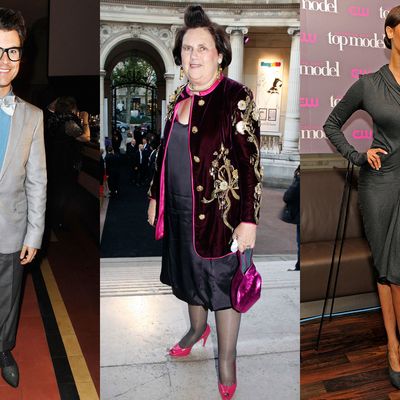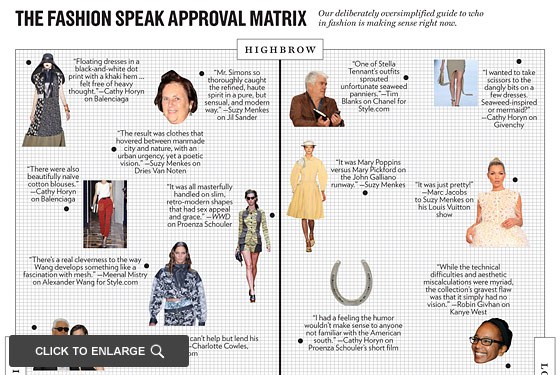
The vice-president of men’s design for Club Monaco, Aaron Levine, is a jovial, thickly bearded, and charmingly burly man. He’s hardly the type many would associate with fashion obsession, but he does have something aside from that in common with her reality eminence Rachel Zoe: He speaks his own language. “Those are nasty,” he declares sporadically in the early fall, when he sees an item in Club Monaco’s men’s department that he likes.
This means he likes them. Call it his version of Zoe’s signature, “I die.”
Despite these phrases not meaning much, they’ve become the basis of fashion conversation among the masses. It’s no longer enough to say you simply like a certain sweater, or that you find a cocktail dress flattering. Such pedestrian words have fallen out of fashion in favor of exaggerated language that, while expressing enthusiasm for clothes, doesn’t give us any insight into why they’re so wonderful. We have come to expect the world’s fashion authorities to “die” or “stop breathing” when they find a pair of shoes that’s especially “fierce” or “tranny,” or perhaps when they find a model “werking” a particularly “mayjor” “smize” or “lewk.” And we’re happy with this, even though precious few of the world’s most famous fashion experts truly make a habit of articulating why certain clothes can be so great.
A very different kind of confusing language also appears in outlets that are far from reality television. Fashion reviews in papers like the New York Times or Women’s Wear Daily are peppered with beautiful phrases that leave readers with only a vague understanding of why clothes are good or bad — and we’re in for a huge new slew of those phrases now that the shows are starting anew tomorrow. In September, Suzy Menkes told us Raf Simons’s Jil Sander collection “caught the refined, haute spirit in a pure, but sensual, and modern way,” while WWD wrote that the Prada collection “took a sweet turn, but with an overt schoolgirl vibe challenging for adults.” Yet, the paper added, the “lineup played as all chic, with endless gloriously adult wardrobe options.” Huh?
But there are people to turn to when it all becomes too much of a headache. Naturally, these include Stanford Linguistics professor Penny Eckert, who describes herself as “not a consumer of fashion discourse.” She noted one key discrepancy between the two schools of fashion conversation. One offers analysis (the papers) and one skips it entirely (many reality shows). “You could always look at it as saying well [Rachel Zoe] doesn’t have an analysis,” she explains. “Another is, well, when you talk to people, when you presuppose common ground. It’s one way of creating connections and creating community, so she’s creating a connection with the reader.” In reading Menkes’s Sander review, she said, “As an outsider, I say this probably means something but I don’t know what.” I said a lot of us very regular consumers of fashion discourse don’t know, either. “There’s an interesting thing, too, that if you grab hold of abstractions, that puts you in an authoritative position,” she replied.
Such abstract language reminded her of the work of anthropologist James Ferguson, who studies urban life in the Copperbelt in Africa, and “commented that there are people in urban settings who would make stylistic moves that were meaningless. You take something” — an outfit, let’s say — “and tweak it in some way — you add something, you subtract something, so people can interpret it. And sometimes there are these uninterpretable moves that that signal that a person is part of this cosmopolitan, urban world, and that people won’t be able to interpret what the stylistic moves are. So it’s pure mystification.”
So ultimately, the language mirrors the runways: Not all of this has to make sense to work (werk?), or, frankly, make its creator some money. So while it makes more sense to describe clothes as pretty or flattering or well-made, people talking about fashion from on-high can only say that stuff so many times before the bore themselves — and all of us — into not paying attention.
Now, do enjoy our handy approval-matrix-style guide of the quippy-iest and thinky-iest fashion speak from the past runway and television seasons.





